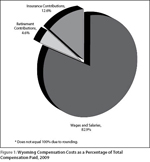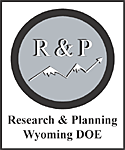Examining Benefits in Wyoming
Health and retirement benefits have long been important tools for employers in recruiting workers, but access and costs for these benefits, especially health insurance, vary by industry. While there are several benefits surveys conducted at the national level, it is important to collect and analyze these data at the state level as well.
Typically, national data tend to focus mostly on which employees have access to health and retirement benefits. The Wyoming Benefits Survey contains information not only on which employees have access to these benefits, but also which employers offer health insurance, retirement, and many other benefits based on industry, employer size-class, and full- or part-time work status.
The 2009 benefits survey questionnaires were mailed to a sample of 2,844 Wyoming employers, or approximately one-tenth of the state's employers. Of those, 2,169 (70.3%) were completed and returned. A total of 443 (15.5%) employers were removed from the sample because valid data could not be collected due to a lack of address information, the company being out of business, or a refusal to participate. This resulted in a net total response rate of 90.4%.
Total compensation refers to the amount of money an employer spends on wages combined with the amount spent on benefits. Contributions to insurance plans and retirement plans represent the majority of compensation other than wages. In Wyoming during 2009, 4.6% of total compensation consisted of contributions to defined-benefit and defined-contribution retirement plans and 12.6% went to medical, dental, and vision insurance plans (Figure 1).
Figures 2 and 3 show thepercentage of employers that offered health and retirement benefits in 2009 and the percentage of full-time employees who were offered those benefits by industry. Natural resources and mining (91.8%), educational and health services (91.6%), and state and local government (99.0%) had the highest proportion of workers offered health insurance. However, just over half of the  employers in natural resources and mining (58.8%) and in educational and health services (52.4%) offered this benefit. Nearly 9 out of 10 (87.1%) of workers in state and local government were offered health insurance.
employers in natural resources and mining (58.8%) and in educational and health services (52.4%) offered this benefit. Nearly 9 out of 10 (87.1%) of workers in state and local government were offered health insurance.
Natural resources and mining (90.2%), educational and health services (89.2%), and state and local government (98.8%) were also the industries with the largest proportion of workers offered retirement benefits. Information (64.6%) and state and local government (87.1%) had the largest percentage of employers offering the benefit.
Black, D. & Evans, M. (1997, May). Work, pay and consumer spending, part one: Sales tax collections and total payroll. Wyoming Labor Force Trends, 34(5), Retrieved September 11, 2008, from http://doe.state.wy.us/LMI/0597/0597a2.htm
